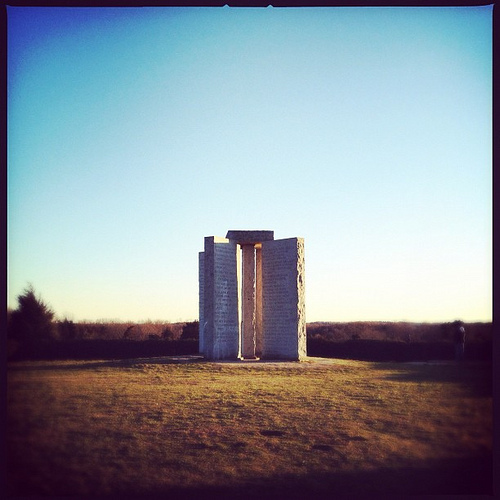By Dessa Bayrock (The Cascade) – Email
Print Edition: April 4, 2012
Georgia was the last of the original 13 colonies of the USA. In 1979, it became home to the Georgia Guidestones – also known as the American Stonehenge.
Jay Fergusun, director and creator of Guidestones: an interactive thriller, was intrigued by this American phenomenon when he first heard about the monument in 2009 from an article in Wired magazine.
“I decided to do a little snooping at various forums pertaining to conspiracies,” Ferguson said in an interview on guidestones.org. “You know, things that would not necessarily be easily placed into an article in a major publication.”
Some information about the Guidestones is readily available, although not much. The structure was commissioned by person or persons unknown under the pseudonym R. C. Christian, and is composed of four slabs of granite that stand nearly 20 feet high, each side inscribed with what could almost be considered commandments: Maintain humanity under 500 million people, in perpetual balance with nature; guide reproduction wisely – improving fitness and diversity; unite humanity with a living new language; rule passion, faith, tradition and all things with tempered reason; protect people and nations with fair laws and just courts; let all nations rule internally, resolving external disputes in a world court; avoid petty laws and useless officials; balance personal rights with social duties; prize truth, beauty and love – seeking harmony with the infinite; be not a cancer on the Earth – leave room for nature – leave room for nature.
These 10 instructions are carved into the granite sides of the structure in eight different modern languages (including English, Spanish, Hindu, Chinese and Swahili) and four ancient languages are inscribed on the top of the stones. it has been speculated that these are the rules for a new world order, but after 33 years there is still very little information about them.
In fact, this was nearly all the information that Jay Ferguson first read about and inspired the beginnings of Ferguson’s project Guidestones: an interactive thriller. Having worked on this project since he first stumbled across the concept in 2009, it finally came to fruition last week as a “push” web series of 50 episodes.
The series itself is about an exchange student studying journalism in Toronto, who discovers a murder that’s been covered up. She begins to find clues online, almost as though someone is leading her along, which connect back to a conspiracy and the Guidestones.
Only a few sparse details about the series have been released to the public, which is all part of the mystery; it’s designed specifically to leave the audience hanging and wanting to search for more. After a viewer signs up, an episode will be sent to them once a week, on a timeline specific to each viewer; if a friend signs up four weeks after you do, for instance, they’ll begin at the start of the series and the episodes will be released to them at the same rate.
The story is based on real events. When Ferguson first began research on the Georgia Guidestones and diving into conspiracy websites and blogs, a woman by the name of Sandy contacted him, and as Ferguson notes, “seemed to have interesting insights.” After a few months, Sandy agreed to meet in person, and turned out to be “a very together and strong woman,” which Ferguson admits was completely unexpected.
A lot of details from her personal experiences made it into Ferguson’s series, and although he says the team “took many creative liberties” in cobbling it all together, the basics are the same. Sandy, like the protagonist in Guidestones, is also an exchange student in a journalism program in Toronto who found herself “wrapped up in a legitimate murder mystery” while doing a class project. Clues on the Internet led her deeper into the conspiracy, and although Ferguson eventually hired a researcher to help compile information, he admits that throughout his investigation process, he still relied on this journalism student to make sense of things; as he says, he turned to her “to clarify certain things and she would often fill in some important gaps.”
This combination of the Georgia Guidestones, an unsolved murder and a journalism student was intriguing to Ferguson, but he knew a documentary was never an option: he could never get Sandy to go on record, and “most of the other principals were either dead or impossible to find.” Finally Ferguson decided on a documentary format with fictionalized elements, which would give him enough creative freedom to dive into the realism of the story without directly involving—and endangering—Sandy. This also allowed him to develop interactive material for viewers as well – clues to help eager audience members follow the plot along faster than the one-episode-per-week pace.


